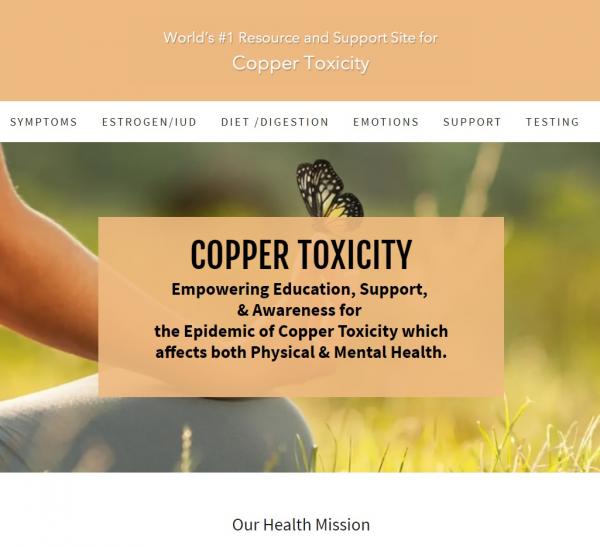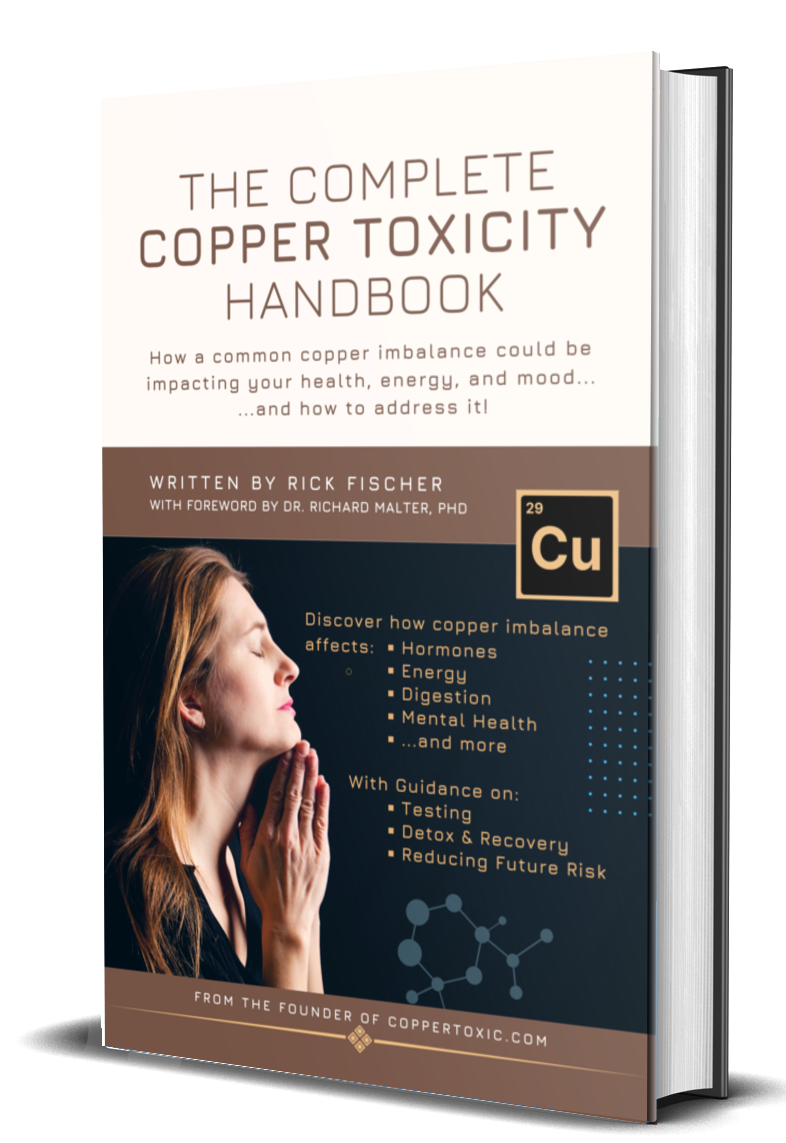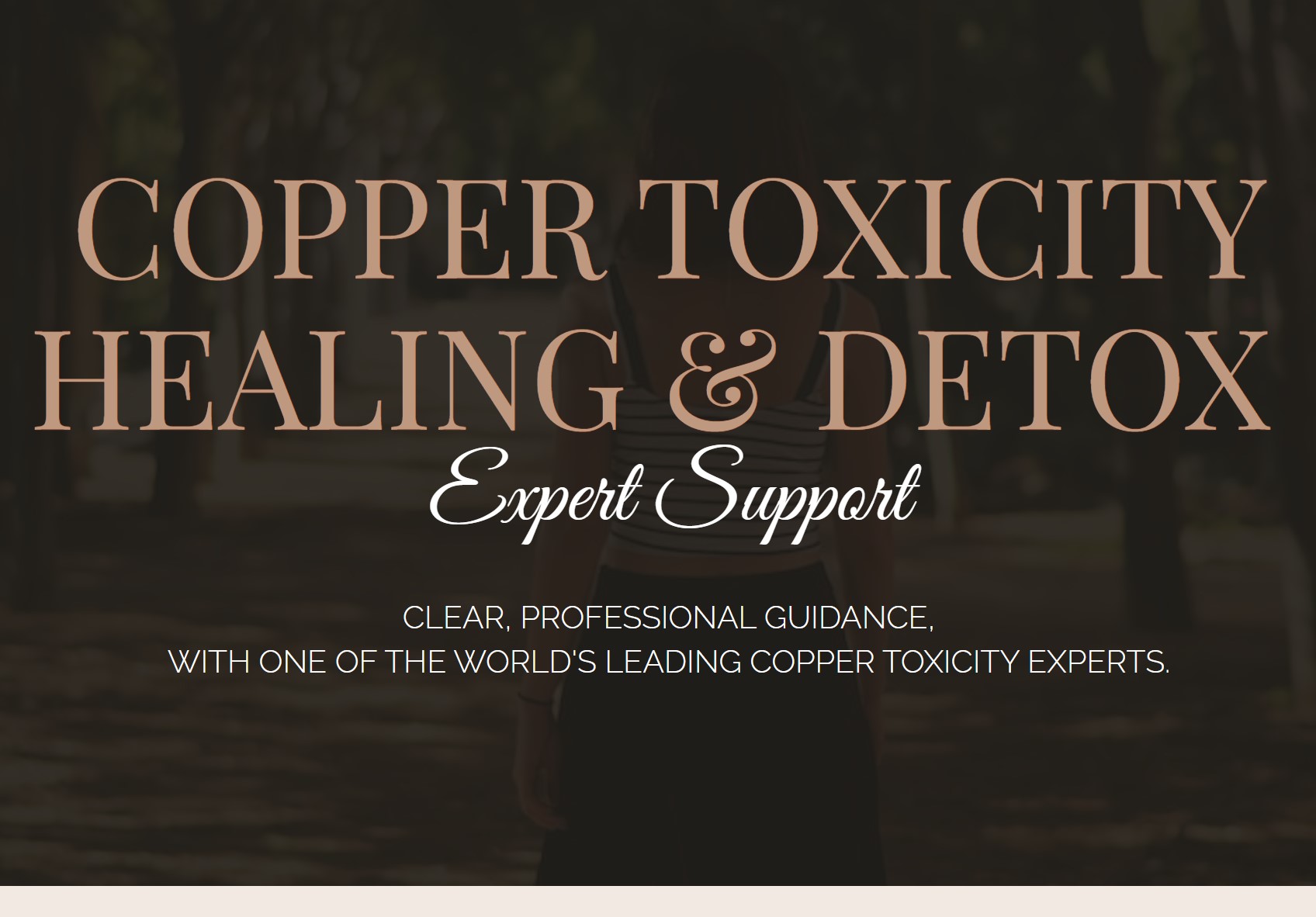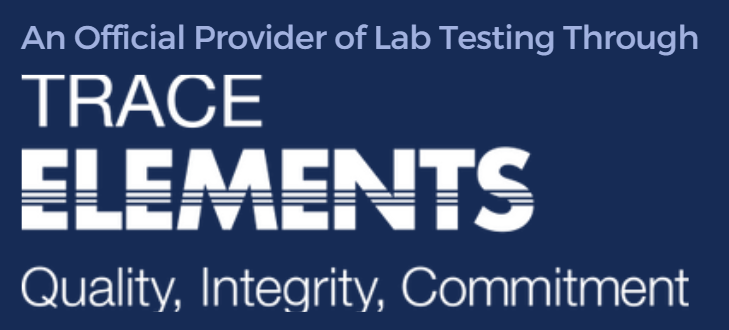15 COMMON MYTHS THAT HOLD BACK WIDER ACCEPTANCE OF HTMA AND COPPER TOXICITY
While research has existed (and experts have warned) about copper toxicity for the past 50+ years, these voices and warnings have been drowned out among the noise of myths that year after year get perpetuated and keep the public away from discovering, and understanding, the nature of copper toxicity and how to address it. Even in one of today's largest copper toxicity related "support" groups, the daily feed often perpetuates many of these very myths. This has left those affected stuck in a stream of confusion, wondering why they're not healing, why they haven't heard of copper toxicity before, and ultimately, distracted from finding many of the professional support and education resources that otherwise could help bring them clarity, and healing.
This page presents 15 of the most common myths, along with some background and explanation for each. Each one of these points is explained in even further detail and clarity within The Complete Copper Toxicity Handbook. Much of this information is also provided on www.coppertoxic.com.
MYTH #1: There's no such thing as copper "toxicity", afterall copper is an essential nutrient!
There are numerous examples of nutrients which are essential yet which, in excess, are recognized as toxic or dangerous. Take, for example, selenium, iron, or even Vitamin D... all essential nutrients, yet when in excess can lead to selenosis, iron toxicity, and hypervitaminosis D, respectively. Yet, when it comes to copper, mysteriously those lessons taught to us by other essential nutrients are forgotten and dismissed. Not to mention, copper ions themselves are known to be cytotoxic. The nature of copper as an essential nutrient does not in any way take away from the harm it can cause to the body when left to accumulate in excess. I also discuss this further on this page.
MYTH #2: Take zinc to detox copper!
How often have people been told to "just take zinc to detox copper". Unfortunately, this is one of the most widely spread misconceptions on the topic. This myth of "just taking zinc" stems from the fact that zinc is important in the regulation of copper absorption (in other words, a zinc deficiency can make one more prone to copper building up). However, once copper is built up and stored in the body, the role of zinc in the detox of copper is minor. There are numerous other nutrients and considerations that must be given to properly address copper detox. Why you "don't just take zinc to detox copper" is explained more in this article.
This same myth extends to other over-simplistic suggestions such as "just take enzymes... just take zeolite... just take these herbs...etc". The proper regulation of copper involves so many more factors that such suggestions ignore.
MYTH #3: Detoxing copper involves just taking supplements
Supplements are there to "supplement" everything else one does. There's this idea that you simply take supplements to heal, and then people wonder why they're not feeling better despite the supplements they're taking. The correct supplements can certainly be extremely beneficial, but even the best supplements need to be looked at as PART of a healing protocol, not as some magic pill that will cure everything. I explain in this article how far-fetched it is to think that just taking a supplement is the sole answer. For more guidance, the "roadmap to detoxing copper" is provided within The Complete Copper Toxicity Handbook - this roadmap provides specific nutrient guidance and far beyond - all the aspects needed to properly support and address the copper toxicity healing process.
MYTH #4: There's no need to take supplements at all (or even detox) because the body regulates itself!
Those promoting this myth demonstrate a complete lack of understanding into the systems which help regulate the body, and the cellular imbalances that affect every human. Of course, if one assumes that we adequately get all the nutrients we need through food, live in a world with zero toxic exposures, have perfect GI health, and look only at blood levels while ignoring cell and tissue levels, it's easy to then assume the body effectively regulates itself. Blood is homeostatic, meaning it has mechanisms that help maintain balance, and thus rarely will the body's various mineral imbalances and toxicities appear in blood. However, the blood regulates itself at the expense of cell and tissue levels. High levels of copper (or other metals) can exist in tissue, and various deficiencies can exist in the cell, and yet typically the blood will still show "normal". Furthermore, especially when it comes to copper, other factors such as biliary impairment, slow motility (constipation), various issues with ATP7B, and issues with the binding of copper onto apoceruloplasmin can all impair the detox and regulation process. These regulation factors are explained further within The Complete Copper Toxicity Handbook.
MYTH #5: The Copper IUD is the only cause of copper toxicity. (Thus, copper toxicity only affects women!)
While for many women it is the copper IUD that makes symptoms appear, and while the copper IUD is certainly one contributing factor to copper toxicity, it is by far not the only cause. Dietary choices, genetics, other specific nutrient imbalances, one's water supply, gallbladder issues, occupational exposure, and even passed down in-utero from mother to child are just some of the additional factors that contribute to copper toxicity. As a result, while women are at higher risk, many men also struggle with copper toxicity.
Furthermore, many women with copper IUDs are in relationships with men. The emotional changes caused by copper toxicity can have a devastating impact on relationships, and it's so important that men are also informed so that they can better support (and understand) their partners. Despite the majority of pioneers in the field of copper toxicity research who've worked to bring this information to the world being males (Pfeiffer, Malter, Walsh, Eck, Watts, Fischer), copper IUD support groups are rife with comments that men have no business being in such groups. Such ignorance has built an additional barrier to being able to provide women with this education and support.
MYTH #6: Symptoms will automatically go away by removing the copper IUD.
As explained in the previous point, the copper IUD is not the only cause of copper toxicity, and therefore removal of the IUD does not guarantee "healing". Certainly, many women feel better after removal, however just as many women don't, or sometimes feel even worse. Removing the IUD (or any other source of exposure) does not automatically "fix" the body's mineral system. It does not automatically address every other imbalance in the body, or eliminate other toxins in the body that could also be causing symptoms. Most fundamentally, not all health conditions stem from copper toxicity! Millions of people everyday struggle with energy, gut, liver, mental health and other issues that have nothing to do with copper. Removal of the IUD is therefore a wise step in terms of supporting the body's health. However, for most people, healing and optimal health involves MUCH more than just removal.
MYTH #7: Copper Toxicity is an iron issue, and by simple reducing iron, copper will fix itself.
Since as far back as 2014, a prominent online "protocol" has called copper toxicity a "myth", instead suggesting that most symptoms are caused by iron. Over the years, the group has repeatedly attacked and even banned leading researchers for simply offering to provide their members information on copper toxicity. Attempts to teach have been blocked, women with copper IUDs are told there's no such thing as copper toxicity, and ironically, that protocol is now occasionally promoted on copper toxicity support groups with unsuspecting copper toxic members cheering for one of the very groups that held back this knowledge in the first place! This has added to public confusion and has created an additional barrier to increasing copper toxicity awareness and supporting women affected with finding clear answers. Of course, when a vegan develops copper toxicity and yet it's blamed instead on having too much iron, or when a woman's symptoms develop directly after getting a copper IUD and she's told that it's just iron, or when parents and partners do post-mortem hair analyzes on loved ones after committing suicide post-copper IUD insertion and a sky-high copper level is verified, it becomes not only nonsensical but also tragic that women have been denied and blocked from receiving this information.
MYTH #8: All copper toxicity symptoms are caused by copper.
Often, those with copper toxicity are led to believe they simply need to get rid of (or "fix") their copper level. However, copper is merely one mineral in the body. There are many others. Imbalances in any one of the other minerals can also contribute to symptoms. Plus, there are all the effects of toxic metals, mold, chemicals, gut dysbiosis, parasites, and a plethora of other factors that can further lead to poor health and symptoms. While copper toxicity can certainly contribute to a number of symptoms, it is not the only cause.
Furthermore, one of the most common misconceptions seen in copper-toxicity-related FB groups is that copper IUD symptoms are just from copper, and therefore eliminating copper will be the answer. This, however, is not how minerals work. Similar to a set of standing dominos, excess copper is like the first domino being knocked over, which then knocks over all the other dominos (those dominos being your minerals). By simply "detoxing" copper (or picking up that first domino), that does not, by itself, fix all the other dominos that have also fallen over. Each one of those imbalances which copper affected can also be contributing to symptoms, and should be given attention to. This is why Hair Analysis testing is so beneficial in understanding the full mineral system.
MYTH #9: HTMA (Hair Analysis) is not a useful or trustworthy test.
Two primary factors have fed this myth:
- HTMA has had a history of smear campaigns directed against it, aimed at suppressing (discrediting) this important screening tool. Countless people have been steered away from doing HTMA because they read somewhere online that HTMA is “quackery” and not reliable. In 1985 and again in 2001, the Journal of the American Medical Association published two studies which, on the surface, seemed to dismiss the accuracy and reliability of HTMA. These results were widely publicized, and to this day are still being widely referenced as justification for HTMA not being reliable. What people don't realize is that the hard data from those studies validated a 99% accuracy rate between the two leading labs (TEI and ARL)! Yet, the studies were published in such a way as to hide that accuracy rate and instead discredit the reliability. In fact, the doctor behind the first study was declared "biased and unworthy of credibility” by a California Appeals Court! However, given his title as a ‘doctor’, those who haven’t researched his agenda or background have fallen victim to his claim that HTMA is not reliable. The irony is that medically accepted serum blood testing is relied upon without question, even though it offers almost no correlation with the stored tissue levels of minerals and metals. Excess copper is stored in tissue, not blood! Over-reliance on blood, while keeping HTMA off of people's radar, has further blocked the wider understanding and acceptance of copper toxicity.
- Added to this are the increasing numbers of people who simply assume that an HTMA can be read at face value, or they'll turn to Facebook for interpretation (which invites guesswork and untrained commentary), or they'll assume that supplements suggested in an automated lab report are adequate. All of this has further fueled mass confusion. We are constantly reminding people that an HTMA is simply a screening tool for the body's mineral system, and requires professional interpretation and guidance after receiving the results. It is NOT meant to be read at face value, guessed at, or assumed that automated suggestions are adequate. We rarely go off of the lab recommendations, but rather specialize in customized plans that consider each person's health history and symptoms. Yet, when people choose not to have professional consultation and instead simply order an HTMA and then follow some automated report suggestion, inevitably confusion ensues.
There are thousands of peer-reviewed references that support HTMA. Dismissing HTMA as pseudo-science begs the question 'what is the person's agenda?'. Human hair is accepted as an effective tissue for biological monitoring of toxic heavy metals by the US Environmental Protection Agency and is being used for this purpose throughout the world. Yet, it MUST be interpreted properly, and accompanied with professional and personalized guidance.
MYTH #10: All "Hair Analysis" testing is the same.
Adding to the confusion surrounding HTMA and claims that it is not "valid" is the fact that there are various forms of "hair analysis" on the market. Most definitely, not all are suitable for the purpose of understanding copper toxicity or symptoms of mineral imbalances. Some "hair analysis" services focus on food sensitivities, some hair analysis labs wash the hair sample which can alter specific mineral levels, some other services pull out a hair follicle and scan it overseas and immediately receive a fancy report beamed back across the airwaves! None of these are ideal for understanding copper toxicity, and certainly the validity of some of these "hair analysis" services could be questioned. Imagine giving a blanket statement such as "water is bad for you!". Such a statement ignores that, while yes there are some forms of (polluted) water that are certainly not healthy to drink, other forms of water can most definitely be beneficial. Not all water is the same. Likewise, not all "hair analysis" is the same. Some forms are a lot more scientifically backed and credible than others, and writing them all off as the same is like the expression "throwing the baby out with the bathwater".
MYTH #11: HTMA is a cure! (It doesn't work if I'm not cured!)
As powerful as personalized HTMA guidance can be, HTMA by itself should not be expected to "heal" a person. HTMA provides you with a powerful nutritional and detoxication road map. However, that is just one layer of a huge onion. Think about it, a person wouldn't do a blood test and then blame the blood test for "not working" if they didn't experience miraculous healing afterward. Yet, some who do HTMA in an attempt to "heal" complex health conditions will then point the finger at HTMA when they haven't healed and say the HTMA didn't work. There are so many windows through which to view the body. HTMA is merely one window. For complex health conditions, there are several other functional tests which could be done to view certain aspects of health more specifically (for example, GI Map for the gut, OAT test for organic acids and methylation, DNA (also methylation insight), MycoToxin testing (for mold and mycotoxins which could be playing a role), etc etc... Equally important are all the lifestyle adjustments one may also need to make to foster better health. Again, HTMA, and even testing in general, is just one part of a much bigger healing process, as explained further in the article here.
MYTH #12: A low HTMA copper level means no copper toxicity.
Definitely not. The assumption that HTMA can simply be read at face value further promotes confusion over HTMA and the existence of copper toxicity. Frequently, people who suspect they have copper "toxicity" have an HTMA test come back showing a "low" copper level. They'll then post their chart on some FB group, and a wave of confusion ensues. Proper HTMA interpretation takes months, if not years, of experience to master, and professional interpretation is essential. Unfortunately, posting an HTMA chart on FB draws commentary from hundreds of untrained people, and the myths that "copper toxicity doesn't exist", or "HTMA isn't valid" take hold. Even without posting on social media, HTMA charts are NOT meant to be read at face value, and all too often people will simply order an automated report and then end up more confused than ever.
Excess copper is stored primarily in the liver, before ending up in other body tissue. The body can have loads of copper in the liver, but if it's not being mobilized into blood, that copper is not going to reach the hair. There are many indicators that must be looked at as a whole to better understand a copper toxicity condition, even if the HTMA copper level appears low. Copper toxicity commonly exists even in cases of a low HTMA level, and professional personalized interpretation of HTMA is so important!
MYTH #13: A standard blood test by your doctor will tell you if you have copper toxicity
Blood is merely a transport system, it is not where minerals (or metals) get stored. The body works quickly to remove excess copper out of blood, often pushing it into tissue storage. Thus, when a doctor runs a typical blood test and copper comes back unflagged (normal), this absolutely does not rule out the possibility that there may be a higher level of copper stored in body tissue. The over-reliance on medically accepted blood testing adds to why copper toxicity gets dismissed, because in most cases the blood does not show high copper.
In some cases, of course, the blood copper can be high. This can certainly offer a clue to an underlying copper toxicity condition (and some cases have been discovered this way), however even a high blood copper level needs to be considered within a broader context. Other factors can elevate blood copper, outside of copper toxicity. For some people, an elevated blood copper level provides them (or their doctor) a clue that there may be a copper toxicity issue. However, for the greater majority, the blood copper level comes back within range, the doctor says there is no issue, the patient is told "they're fine", and a potential underlying copper toxicity condition gets overlooked.
MYTH #14: Most people are copper deficient, so it's actually important to take more copper!
Well, this is a "partial" truth. And widespread copper "deficiency" is the hook used by those selling copper products or dismissing the notion of copper toxicity. If there's a "deficiency", then there can't possibly be a toxicity, and people need to take more! Yet, this view shows the basic lack of understanding that a deficiency can exist due to a metabolism issue, not necessarily due to a "true" deficiency or lack of intake. For example, a person can have lots of soft tissue calcium (not good), and yet be losing calcium from bone (deficiency). A person can have iron build-up, but their "availability" of iron might be low due to low stomach acid, low ceruloplasmin, etc. Likewise, a person can have lots of stored copper in their body, and yet be deficient in terms of bio-availability at the same time. In fact, excess copper accumulation, by way of affecting the adrenals, liver and the body's mineral system, can actually contribute to the body not being able to optimally use copper. In other words, the excess itself can contribute to the deficiency! It is therefore misleading, and frankly negligent, to simply say "you're deficient, so take more" without properly testing first.
MYTH #15: There's a "one-size-fits-all" supplement or protocol that everyone with copper toxicity should take / follow.
There are general supplement / nutrient recommendations for copper toxicity as outlined at www.coppertoxic.com/healing and in even more detail within The Complete Copper Toxicity Handbook. However, it is imperative to understand that these are GENERAL considerations, and may not be suited to everyone. For example, magnesium, B6, and vitamin C are all useful nutrients for copper toxicity in general, yet too much magnesium may backfire if a person's sodium is too low; B6 might not be tolerated with certain genetic variations; and likewise there's caution with vitamin C in those who have oxalate issues. The correct form of each nutrient also matters, and once again will depend on the individual. Medications, health history, diet, and symptoms will also influence nutrient / supplement requirements. One-size-fits-all protocols, while they might sound enticing, should be a red flag. Likewise, it should be a red flag anytime someone tells another person on a FB group to simply "take XYZ" without a proper understanding of that person's unique situation. Just because one person took 50mg of zinc and a zeolite binder and felt good does not automatically make that suggestion suitable for someone else, and indeed such blanket suggestions often backfire and make others worse...not to mention... further fuel confusion.
NEEDING PROFESSIONAL EXPERTISE AND CLARITY?
We're home to the leading copper toxicity education & support resources

CopperToxic.com
Since 2014, the #1 website for copper toxicity education, awareness, and support.

The Complete Copper Toxicity Handbook
Bringing together the past 50 years of copper toxicity research, this seminal book brings vital clarity to copper toxicity and a clear roadmap for healing.

Mineral Mastery
The original home-study course at the forefront of mineral-based health education, including a special focus on copper toxicity and detoxing. For practitioners and everyday individuals alike, this is an education that truly empowers students to connect the dots and find answers when it comes to health.

Full Copper Toxicity Support Library
The largest collection of professional support resources for copper toxicity, along with industry-leading HTMA support packages and consultation.
Follow Us
Copyright © 2014-2024 Integrative Health Coaching & Rick Fischer - All Rights Reserved.
All content and articles on this site may not be copied in whole or part without expressed written permission by Rick Fischer.
